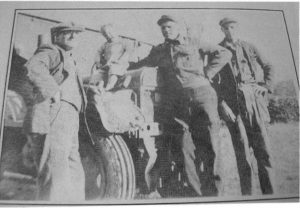Calvert during the second world war
In 1939, London Brick drivers were seconded to military service. 57 of the company’s vehicles were used and less than 12 returned after the war.
In one day, 820,000 bricks were made as demand increased for deliveries to sites building air raid shelters.
The brickworks became increasingly run by women and later Italian and German prisoners of war arrived.
During the war, a train arrived at Calvert Station from London with a number of evacuees. They were transported to Charndon school and the local women were told to receive them there. Because no one was told which child was allocated to them, they all got picked until a brother and sister were left who did not want to be parted. Mrs Molly Stuchbury took the siblings home.
CALVERT BRICKWORKS
After the second World War, accommodation for employees was built as the need for bricks to replace war damaged housing was overwhelming. Calvert produced over 6 million bricks weekly post-war. There was a hostel too that housed German and Italian POW’s and other Displaced Persons who could not return to their countries which had been taken over by Soviet Russia. The photo is from left: Tom Stutchbury from Tingewick, David Seward who lived at 4 Brackley Lane, Calvert and 2 POW’s probably Germans.

